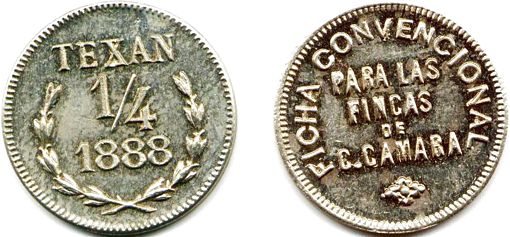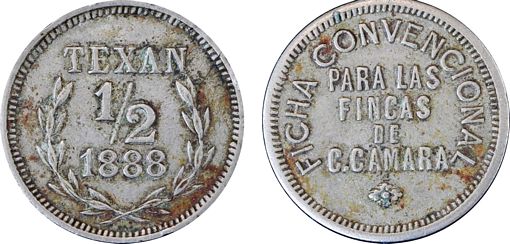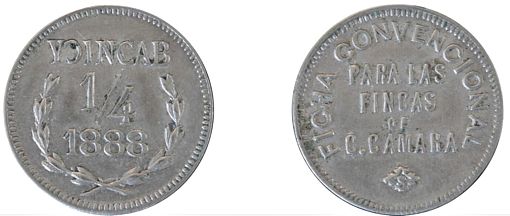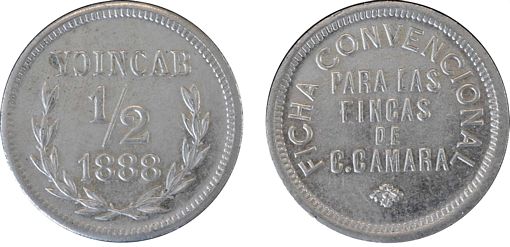Hacienda tokens from Yucatán (the Cámara family)
The Cámara family is the oldest Creole family in Yucatan as Juan de la Cámara came to the peninsula with Montejo. The Cámara family also exerted significant influence in the second half of the 19th century and the beginning of the 20th century.
Numerous haciendas, such as Hacienda San Antonio Cámara, Hacienda Chucmichén, Hacienda Santa Ana, Hacienda Xcalak, Hacienda San Diego Azcorra, Hacienda Itzincab Cámara, Hacienda Polyuc and Hacienda Dzuiché, among others, were under the ownership and influence of Cámara family members during the early years of the twentieth century.
Alfonso Cámara y Cámara
Alfonso Cámara y Cámara was a conservative politician who served as vice governor of the state during the administration of Francisco Cantón. In 1902, Canton proposed him as his successor, but Porfirio Díaz, the dictator who ruled Mexico for 30 years, favored the candidacy of his rival, Olegario Molina.
Raymundo Cámara Luján
Raymundo Cámara Luján was the owner of numerous farms in Temax, among which the haciendas of San Antonio Cámara and Chumichén stand out. Together, these haciendas had a combined area of 7,812 hectares devoted to henequen farming. Raymundo was also the owner of the Hacienda de Tekik, a henequen hacienda in Timucuy.
In 1887, he partnered with the Villamil Vales family to found the Compañía Particular de Fomento de Fincas, S.A., with the aim of exploiting and producing henequen. They acquired the Hacienda San Diego Tixcacal in Opichén, the Hacienda de Santa Cruz, and the Hacienda de Subintal in Huhí for this purpose,
His agricultural activity was not only limited to the production of henequen, as he was also the owner of several sugar mills dedicated to the production of sugar cane. After Manuel Cicerol, owner of the Hacienda de Catmís in Tzucacab, Cámara Luján became the second most important producer of sugarcane in the Yucatan Peninsula. Among the mills operated by Cámara Luján, the Hacienda de Dziuché in Hoctún stands out, which produced around 12,000 kilograms of sugar and 10,000 kilograms of honey per year.
Similarly, he owned the Hacienda Polyuc, a sugar mill located in Tekax. Between 1906 and 1909, this hacienda was managed by José María Pino Suárez, son-in-law of Cámara Luján.
Along with Felipe Peón, Eusebio Escalante, and Rafael Hernández Escudero, Cámara Luján owned the Hacienda Yokat in TiculFriedrich Katz, Agrarian serfdom in Mexico in the Porfiran era, 2013. Ediciones Era. Yokat was a cattle ranch, as well as a sugar and henequen plantation. The Haciendas of Yokat and Polyuc were sold to Augusto L. Peón after the financial panic of 1907.
Again associated with Escalante, Cámara Luján was co-owner of a 2,627 km² plot of land that included the Hacienda de Santa María in Quintana Roo (Compañía Agrícola del Cuyo y Anexas, S.A.).
Influenced by his son-in-law, José María Pino Suárez, a lawyer and social reformer, Cámara implemented progressive labor practices, providing favorable working conditions for workers in his mills. He introduced reforms such as establishing a minimum wage, an eight-hour workday, and ensuring labour mobility and the ability to negotiate working conditions on all farms. In addition, he prioritized education by establishing rural schools on his properties to teach basic reading and writing to workers and their families. Notably, the Hacienda de Dziuché became a precursor to labor unions, inspiring other landowners in Yucatán to follow suit. Camara's progressive ideals were grounded in his Catholicism and his belief in treating workers with respect, while recognizing the practical benefits of better conditions in terms of productivity and profits. Although his reforms faced criticism from some ranchers who saw them as costly and detrimental to the henequen industry, they ultimately improved the lives of thousands of workers in Yucatan.
At the dawn of the 19th century, Cámara teamed up with his brother-in-law, José María Ponce Solís, to establish the José M. Ponce y Cía trading house, which quickly became one of the leading exporters of henequen. Between 1898 and 1902, his company was responsible for exporting approximately 16% of henequen fibre bales, amounting to about 13 million kilograms annually to the U.S. market. In addition to their role as exporters, the company became a financial institution, granting loans to both henequen producers and entrepreneurs in various sectors. Notably, they played a crucial role in financing the construction of the railway connecting Mérida and Valladolid, later expanding this network to include the route from Conkal to Progreso. This infrastructure was instrumental in efficiently transporting henequen from the northeastern region of Mérida to shipping ports. However, by 1904, the operations of the company led by Ponce Solís y Cámara came to an end. The company's sudden demise can be attributed to a combination of political and economic factors. In the political sphere, the government of General Cantón was replaced by Olegario Molina, marking the transition to the first civilian governor of the Porfiriato. The political collaboration between General Cantón and José María Ponce Solís, who had also served as mayor of Mérida from 1900 to 1902, came to an end. In the same year, International Harvester was born, the result of the merger of sixteen American companies dedicated to the manufacture of agricultural machinery and cordage. This merger created a near-monopoly on henequen fibre, consolidating its control of the market. The fate of the henequen market was sealed with a secret agreement between Olegario Molina, then governor (though formally separated from his company), and International Harvester, which kept fibre prices artificially low in exchange for acquiring increasing volumes of the Yucatecan product.Because of this secret cartel, the United States, being the leading importer of henequen, went from being a price taker to a price maker, causing the price of henequen to fall from about $9.48 per pound to a flat rate of just eight cents per pound. Faced with this new market reality, Ponce and Cámara strategically decided to reduce their share of the henequen market and began to diversify their interests. In 1900, they ventured into a new business direction, opening Cervecería Yucateca, S.A., a brewery.
In 1890, the Mercantile Bank of Yucatán, S.A., the first bank in the region, was founded. In 1890 Cámara was one of founders of the Banco Mercantil de Yucatán and participated in its first board of directors. The bank maintained close ties with the business interests of the Escalante and Cámara families. However, it faced strong competition from Banco Yucateco, which was associated with the Molina family. Amid the Panic of 1907, a severe economic crisis on an international level, both banks were greatly affected and were forced to merge, forming the Banco Peninsular Mexicano.
Camilo G. Cámara
Finca Texán
This finca was located 15 kilometres south of Mérida.
 Grove 1412
Grove 1412
Obverse: above a laurel leaf, TEXAN / 1/4 / 1888
Reverse: FICHA CONVENCIONAL / PARA LAS . FINCAS / DE / C. CAMARA
17mm. nickel

Grove 1413
Obverse: above a laurel leaf, TEXAN / 1/2 / 1888
Reverse: FICHA CONVENCIONAL / PARA LAS . FINCAS / DE / C. CAMARA
21mm. nickel
Hacienda Itzincab Cámara (Finca Ytzincab)
This finca, was located in the municipio of Tecoh, just 25 kilometres south of Mérida. The hacienda was purchased in around 1860 by Camilo G. Cámara. As early as 1898, Cuban workers were being used on the farm. In 1905, salary reports show 22 of the workers were from the newly arrived Korean indentured servants.
In the 1930s with the land reforms passed under the agrarian acts the size of the hacienda was greatly reduced. In 1934, the family retained 211 hectares. By 1981 only 14 hectares were still part of the hacienda and when the Cámara family sold the property in 1996, the property had 4 hectares of land remaining.

Grove 1420
Obverse: above a laurel leaf, YƆINCAB / 1/4 / 1888
Reverse: FICHA CONVENCIONAL / PARA LAS . FINCAS / DE / C. CAMARA
17mm. nickel

Grove 1421
Obverse: above a laurel leaf, YƆINCAB / 1/2 / 1888
Reverse: FICHA CONVENCIONAL / PARA LAS . FINCAS / DE / C. CAMARA
21mm. nickel
José Cámara Vales
Hacienda San José
This hacienda is located in the municipio of Mérida.
Obverse: HACIENDA SAN JOSE / JOSE CAMARA VALES
Reverse: ¼
23mm. nickel
Obverse: HACIENDA SAN JOSE / JOSE CAMARA VALES
Reverse: ½
25mm. nickel
Obverse: HACIENDA SAN JOSE / JOSE CAMARA VALES
Reverse: 1
28mm. nickel
